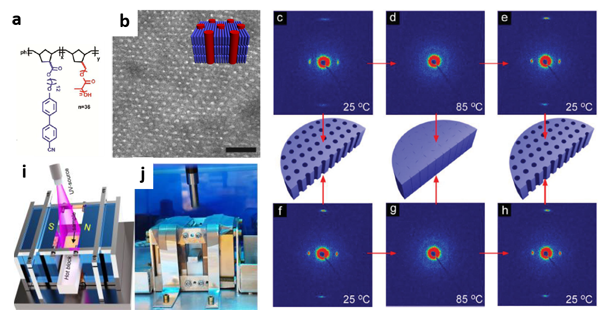|
Graduate Student Office: 266 Mason Lab Phone: (203) 436-4059 |
Since July 2012, PhD student, Yale University, School of Engineering & Applied Science, Department of Chemical Engineering August 2011, M.S. in Chemical and Biological Engineering, Seoul National University, Department of Chemical and Biological Engineering August 2009, B.S. in Chemical and Biological Engineering, Seoul National University, Department of Chemical and Biological Engineering |
|
The primary focus of my research is the study of the directed self-assembly of soft materials to fabricate functional nanomaterials. To achieve this, I’m particularly interested in block copolymers (BCPs) and in using external fields to control their orientation. BCPs self-assemble into spheres, cylinders, gyroids, or lamellae with characteristic length scales of ~10 – 100 nm. However, it is very important to control their orientation over large areas in order to utilize these morphologies for applications such as membranes, lithography masks, or templates for functional nanomaterials, among other applications. Current Research 1: Magnetic field-induced alignment of block copolymers In general, rigid liquid crystalline (LC) mesogens have magnetic anisotropy properties that are degrees of order higher than those of regular coil polymers. Thus we designed norbornene-based brush-like block copolymers which possess LC moiety in one block while the other block has long poly (D,L-lactide) (PLA) chains that can be further etched out by hydrolysis. (Figure 1a) To date, most such brush copolymers were understood to form flat interfaces (lamellae). However, we explored the phase behavior of LC brush-like block copolymers (LCBBCs) systematically, revealing that the LCBBCs accommodate curved interfaces, presenting in cylindrical or sphere morphologies. (Figure 1 b) With the LCBBC platform, we further investigated the material properties. The cylinder-forming LCBBCs were aligned using magnetic fields and subsequently the PLA cylindrical domain was etched to form continuous, low tortuous nanopores. Interestingly, we observed pores collapsing and opening as we heated and cooled across the LC transition temperature. (Figure 1 c-h) More recently, we found a way to align the LCBBCs with sub-Tesla low magnetic fields. (Figure 1 I, j) |
|
Figure 1: a) The chemical structure of PLA-LC LCBBCs. b) TEM micrograph of cylinder forming PLA-LC. The inset shows schematic illustration of cylinder mesophase. c-h) The nanopores show pore collapsing and opening as the sample was heated and cooled across LC transition temperature reversibly. i-j) Custom made permanent magnet set up for low-field magnetic alignment. |
|
|
Current Research 2: Sequential electrospray of block copolymer thin films BCP structure benefits from its uniform size distribution over the entire film and the length scale is readily programmed by thermodynamic equilibrium structure. In the conventional thermal or solvothermal annealing process of spin-coated BCP films, it is challenging to modulate the kinetic parameter and generate heterogeneous structure. We adopted a sequential electrospray technique to the BCP film deposition and studied the microdomain structure using a cross-sectional TEM (Figure 2). One block copolymer species was deposited on a silicon substrate and subsequently another block copolymer was deposited using electrospray. The diffusion coefficient of the incoming polymer chain governed the resulting film structure and the films showed homogeneously mixed structure, heterolattice structure, or intermediate gradated structure, depending on their temperature and molecular weight. Further studies on the various combinations such as BCPs with homopolymer or BCPs with varying morphologies are underway to create unconventional 3D structures. |
|
Figure 2: a) Schematic demonstration of the sequential electrospray deposition of two lamellae-forming BCPs. b) Cross-sectional TEM micrograph of the BCP lamellar heterolattice. |
|
Before joining the Professor Osuji's Lab, I did my master's research at the National Creative Research Initiative Center for Intelligent Hybrids, Seoul National University under guidance of Professor Kookheon Char. I studied the effect of morphological pattern (roughness) on the block copolymer thin films (PS-b-PMMA) by depositing the BCP film on unidirectional silicon oxide nanopattern fabricated by e-beam lithography. In this work, we systematically analyzed the effect of roughness factors, width, period and depth of the pre-pattern and we obtained the directed self-assembled block copolymer nanodomain along the underlying pattern at a specific condition. Self-Consistent Field Theory simulation of the block copolymers with 2-dimensional geometry was conducted to clarify the experimental results.
|
|
|
|
|
|
|


